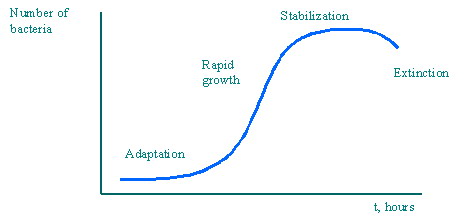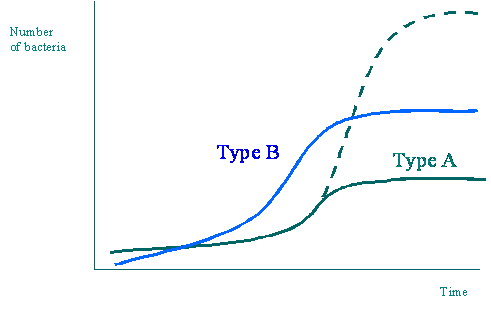Why is it important to start your startup on time?
Who had time, he ate. And it does not matter if we are talking about people, bacteria or startups.
But it is still interesting to find out why things are exactly this way, and why often not the strongest wins, but the fastest.
')
(from this point - a direct reprint of a fragment of this useful material )
It is known that the growth dynamics of the number of bacteria on the nutrient medium is also well described by the S-shaped curve (Figure 21):

Figure 21 Bacteria Growth
Experiments have shown that at first bacteria take some time to adapt to new conditions, so they multiply rather slowly, then, having adapted, they show an avalanche-like growth until they fill all the available space. At this point, the size of the colony stabilizes until the nutrients are exhausted or the medium is saturated with waste products. From this point on, the number of bacteria goes down until extinction.
In addition, it turned out that each type of bacteria has its characteristic adaptation time (similar to the length of the first stage of the vehicle ( Technical System, approx. DPihto )) and its maximum attainable number (similar to the development limit for the main indicators of the vehicle). So, the most interesting thing began when two different types of bacteria were simultaneously placed in one Petri dish. The result is shown in Figure 22:

Figure 22 Increase in the number of bacteria (2 types of populations)
As you can see, type A had a very high growth potential, but a rather long adaptation period. Type B, on the contrary, was very adaptable, but had a very modest potential. And he won in the fight for resources! While his more promising competitor was slowly preparing to turn around in all splendor, he quickly jumped to the stage of rapid growth and captured the whole living space. As a result, View A was completely depressed and extinct, far behind the winner and not having realized his outstanding abilities.
Apparently, similar events unfold in the world of technology. It is clear that the system, which was the first to break out onto the market, due to the resources that became available to it, is rapidly improving its main indicators and becoming difficult for competitors. In addition, it quickly occupies the most easily accessible niches, draws attention to itself and the resources of society, a kind of infrastructure begins to take shape around it, i.e. gaining inertia, sweeping competitors. As a result, the development of outsiders is oppressed (they simply don’t give money), and it remains for them either to die completely, or to wait for the moment when the lucky winner exhales, and their remarkable potential will finally be in demand.
* * *
I think we can independently transfer these observations to the situation with startups.
But it is still interesting to find out why things are exactly this way, and why often not the strongest wins, but the fastest.
')
(from this point - a direct reprint of a fragment of this useful material )
It is known that the growth dynamics of the number of bacteria on the nutrient medium is also well described by the S-shaped curve (Figure 21):

Figure 21 Bacteria Growth
Experiments have shown that at first bacteria take some time to adapt to new conditions, so they multiply rather slowly, then, having adapted, they show an avalanche-like growth until they fill all the available space. At this point, the size of the colony stabilizes until the nutrients are exhausted or the medium is saturated with waste products. From this point on, the number of bacteria goes down until extinction.
In addition, it turned out that each type of bacteria has its characteristic adaptation time (similar to the length of the first stage of the vehicle ( Technical System, approx. DPihto )) and its maximum attainable number (similar to the development limit for the main indicators of the vehicle). So, the most interesting thing began when two different types of bacteria were simultaneously placed in one Petri dish. The result is shown in Figure 22:

Figure 22 Increase in the number of bacteria (2 types of populations)
As you can see, type A had a very high growth potential, but a rather long adaptation period. Type B, on the contrary, was very adaptable, but had a very modest potential. And he won in the fight for resources! While his more promising competitor was slowly preparing to turn around in all splendor, he quickly jumped to the stage of rapid growth and captured the whole living space. As a result, View A was completely depressed and extinct, far behind the winner and not having realized his outstanding abilities.
Apparently, similar events unfold in the world of technology. It is clear that the system, which was the first to break out onto the market, due to the resources that became available to it, is rapidly improving its main indicators and becoming difficult for competitors. In addition, it quickly occupies the most easily accessible niches, draws attention to itself and the resources of society, a kind of infrastructure begins to take shape around it, i.e. gaining inertia, sweeping competitors. As a result, the development of outsiders is oppressed (they simply don’t give money), and it remains for them either to die completely, or to wait for the moment when the lucky winner exhales, and their remarkable potential will finally be in demand.
* * *
I think we can independently transfer these observations to the situation with startups.
Source: https://habr.com/ru/post/60137/
All Articles